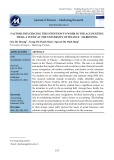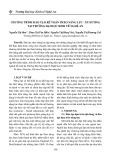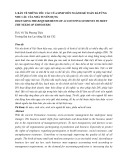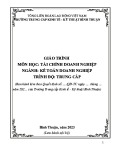
Department
of
Business,
Economic
Development and Tourism
State
of
Hawaii
NOTES
TO
THE BASIC FINANCIAL STATEMENTS
June
30, 2009
NOTE I - CHANGES
IN
ASSETS AND LIABILITIES
OF
THE AGENCY FUNDS (Continued)
Balance
July
1.
2008
ASSETS
Additions
Balance
Deductions June 30. 2009
Cash and other assets
held in trust
LIABILITIES
Deposits payable
$228.599
$228.599
$46.630
$46.630
$24.979
$24.979
$250.250
$250.250
NOTE J - EMPLOYEE BENEFIT PLANS
Defined Benefit Pension Plan
All eligible employees of the DBEDT are required by Chapter
88,
Hawaii Revised Statutes
(HRS), to become members of the Employees' Retirement System of the State of Hawaii (ERS),
acost-sharing multiple-employer public employee retirement
plan.
The ERS provides retirement
benefits as well as death and disability benefits. The ERS issues apublicly available financial
report that includes financial statements and required supplementary information. The report
may
be
obtained by writing to the ERS at City Financial Tower,
201
Merchant Street, Suite 1400,
Honolulu, Hawaii 96813.
Prior to June
30,
1984, the plan consisted of only acontributory
plan.
In
1984, legislation was
enacted to add anew contributory plan for members of the ERS who are also covered under
Social Security. Police officers, firefighters, judges, elected officials, and persons employed
in
positions not covered by Social Security are precluded from the noncontributory plan. The
noncontributory plan provides for reduced benefits and covers most eligible employees hired
after June
30,
1984. Employees hired before that date were allowed to continue under the
contributory plan or to elect the new noncontributory plan
and
receive arefund
of
employee
contributions. All benefits vest after five and ten years
of
credited service under the contributory
and noncontributory plans, respectively.
Both plans provide amonthly retirement allowance based
on
the employee's age, years of
credited service, and average final compensation (AFC). The AFC
is
the average salary earned
during the five highest paid years
of
service, including the vacation payment, if the employee
became amember prior to January
1,
1971. The AFC for members hired
on
or after that date
is
based
on
the three highest paid years
of
service, excluding the vacation payment.
37
This is trial version
www.adultpdf.com

Department
of
Business, Economic Development and Tourism
State
of
Hawaii
NOTES
TO
THE
BASIC FINANCIAL STATEMENTS
June
30,
2009
NOTE J - EMPLOYEE BENEFIT PLANS (Continued)
On
July
1,
2006, anew hybrid contributory plan became effective pursuant
to
Act 179 SLH
2004.
Members
in
the hybrid plan are eligible for retirement at age
62
with 5years of credited service
or age 55 and 30 years of credited service. Members receive abenefit multiplier of 2% for each
year of credited service
in
the hybrid
plan.
All members of the noncontributory plan and certain
members of the contributory plan are eligible to join the hybrid plan. Most new employees hired
from July
1,
2006 are required to join the hybrid plan.
Members
of
the ERS belong to either acontributory or noncontributory option. Only employees
of the DBEDT hired
on
or before June
30,
1984 are eligible to participate
in
the contributory
option. Members are required
by
state statute to contribute 7.8% of their salary to the
contributory option and the DBEDT
is
required to contribute to both options at
an
actuarially
determined
rate.
Most covered employees of the contributory option are required to contribute 7.8% of their
salary. The funding method used to calculate
~he
total employer contribution requirement
is
the
Entry Age Normal Actuarial Cost Method. Effective July
1,
2005, employer contribution rates
are
afixed percentage of compensation, including the normal cost plus amounts required to pay for
the unfunded actuarial accrued liability.
Measurement of assets and actuarial valuations are made for the entire ERS and are not
separately computed for individual participating employers such
as
the DBEDT. For the fiscal
years ended June
30,
2009, 2008, and 2007, the DBEDT made contributions approximating
$1,948,000, $1,790,000, and $1,707,000, respectively, which are equal to their required
contributions. The contribution rate was 15.00% for the fiscal year ended June
30,
2009, and
13.75% for the fiscal years ended June 30,2008 and 2007.
Post-Retirement Health Care and Life Insurance Benefits
In
addition to providing pension benefits, the State of Hawaii Employer-Union Health Benefits
Trust Fund (EUTF),
an
agent multiple-employer plan provides certain health care (medical,
prescription, vision and dental) and life insurance benefits for retired State employees. Act 88
established the EUTF during the
2001
legislative session and
is
codified
in
HRS 87A.
Contributions are based on negotiated collective bargaining agreements and are limited by
State statute to the actual cost of benefit coverage. The DBEDT's share of the expense for
post-retirement health care and life insurance benefits for the fiscal year ended June
30,
2009,
was approximately $773,000.
For employees hired before
JUly
1,
1996, the State pays 100%
of
the monthly health care
premium for employees retiring with 10 or more years of credited service, and 50% of the
monthly premium for employees retiring with fewer than ten years of credited service.
38
This is trial version
www.adultpdf.com

Department
of
Business,
Economic
Development
and
Tourism
State
of
Hawaii
NOTES TO THE BASIC FINANCIAL STATEMENTS
June
30,2009
NOTE J - EMPLOYEE BENEFIT PLANS
(Continued)
For employees hired after June
30,
1996 but before July
1,
2001
and retiring with 25 years or
more of service, the State pays the entire health care premium. For employees retiring with at
least 15 years but fewer than 25 years of service, the State pays 75% of the monthly Medicare
or non-Medicare premium. For those retiring with at least 10 years but fewer than
15
years of
service, the State pays 50% of the retired employees' monthly Medicare or non-Medicare
premium. For those retiring with fewer than 10 years of service, the State makes
no
contributions.
For employees hired after June
30,
2001
and retiring with over 25 years of service, the State
pays 100% of the monthly premium based
on
the self plan. For those who retire with at least
15 years but fewer than 25 years
of
service, the State pays 75% of the retired employees'
monthly Medicare or non-Medicare premium based
on
the self plan. For those retiring with at
least 10 years but fewer than
15
years of service, the State pays 50% of the retired
employees' monthly Medicare or non-Medicare premium based
on
the self plan. For those
retiring with fewer than 10 years of service, the State makes
no
contributions.
The State also reimburses 100% of Medicare premium costs for retirees and qualified
dependents, who are at least 65 years of age and have at least 10 years of service.
The State
is
required to contribute the annual required contribution (ARC) of the employer,
an
amount that
is
actuarially determined. The ARC represents alevel of funding that, if paid
on
an
ongoing basis,
is
projected to cover normal cost each year and amortize any unfunded
actuarial liabilities (or funding excess) over aperiod not to exceed thirty years.
Measurement of the actuarial valuation and the ARC are made for the State
as
awhole and
are not separately computed for the individual state departments and agencies such
as
the
DBEDT. The State has only computed the allocation of the other postemployment benefit
(OPEB) costs to component units and proprietary funds that are reported separately
in
the
State's Comprehensive Annual Financial Report (CAFR). Therefore, the OPEB costs for the
DBEDT were not available and are not included
in
the financial statements. The State's CAFR
includes the note disclosures and required supplementary information
on
the State's OPEB
plans.
The EUTF issues astand-alone financial report that includes financial statements and
required supplementary information, which may be obtained at the following address: State of
Hawaii Employer-Union Health Benefits Trust Fund,
201
Merchant Street, Suite 1520,
Honolulu, Hawaii 96813.
39
This is trial version
www.adultpdf.com

Department
of
Business,
Economic
Development
and
Tourism
State
of
Hawaii
NOTES TO THE BASIC FINANCIAL STATEMENTS
June
30, 2009
NOTE K - NONIMPOSED EMPLOYEE FRINGE BENEFITS
Payroll fringe benefit costs
of
employees
of
the DBEDT funded by state appropriations
(General Fund) are assumed by the State and are not charged to the DBEDT's operating
funds. These costs, totaling $2,886,010 for the fiscal year ended June 30, 2009, have been
reported as revenues and expenditures within the DBEDT's general fund.
Payroll fringe benefit costs related to federally-funded salaries are not assumed by the State
and
are recorded
as
expenditures
in
the DBEDT's economic development special revenue fund.
NOTE L - COMMITMENTS AND CONTINGENCIES
Leases
The DBEDT leases office facilities and equipment under various operating leases expiring
through 2014. Future minimum lease commitments
of
noncancelable operating leases as of
June 30, 2009, were as follows:
Fiscal Year Ending June 30,
2010
2011
2012
2013
2014
Amount
$500,600
323,400
203,900
39,300
4,600
$1.071.800
The DBEDT's rental expenditures related to the above leases for the fiscal year ended
June 30, 2009, were approximately $366,500.
Accumulated
Sick
Leave
Employees hired
on
or before July
1,
2001
earn sick leave credits at the rate of one and three-
quarters working days for each month of service. Employees hired after July
1,
2001
earn
vacation at the rate of one and one-quarter or one and three-quarters working days for each
month of service, depending upon the employees' years of service and job classification. Sick
leave credits may accumulate without limit, but may be taken only
in
the event of illness and
are
not convertible to pay upon termination of employment. However,
an
employee who retires or
leaves government service
in
good standing with 60 days or more of unused sick leave
is
entitled to additional service credit
in
the
ERS.
At June
30,
2009, accumulated sick leave
approximated $8,562,000 for the DBEDT.
40
This is trial version
www.adultpdf.com

Department
of
Business,
Economic
Development
and
Tourism
State
of
Hawaii
NOTES TO THE BASIC FINANCIAL STATEMENTS
June
30, 2009
NOTE L - COMMITMENTS AND CONTINGENCIES (Continued)
Litigation
From time to time, the DBEDT
is
named as adefendant
in
various legal proceedings. Although
the DBEDT and its counsel
are
unable to express opinions
as
to
the outcome of the litigation, it
has been the State's historical practice that certain types of judgments and settlements against
an agency of the State are paid from the State General Fund through
an
appropriation
bill
which
is
submitted annually
by
the Department of the Attomey General
to
the State Legislature.
Currently, the State revised
its
procedures
to
allow payment from adepartment's special fund
rather than the general fund. Consequently, aclaim against aspecial fund of the DBEDT may
adversely affect the DBEDT's
bUdget
and financial statements.
NOTE M - RISK MANAGEMENT
The DBEDT is exposed to various risks of loss related
to
torts; theft
of,
damage to, or
destruction of assets; errors
or
omissions; and workers' compensation. The State records a
liability for risk financing and insurance related losses if it
is
determined that aloss has been
incurred and the amount can
be
reasonably estimated. The State retains various risks and
insures certain excess layers with commercial insurance companies. The excess layers
insured with commercial insurance companies are consistent with the prior fiscal year. Settled
claims have not exceeded the coverage provided by commercial insurance companies
in
any
of the past three fiscal years. Asummary
of
the State's underwriting risks
is
as follows:
Property
Insurance
The State has an insurance policy with avariety of insurers
in
avariety of layers for
property coverage. The deductible for coverage is 3% of loss subject to a
$1
million per
occurrence minimum. This policy includes windstorm, earthquake, flood damage,
tsunami, and volcanic action coverage. The limit
of
loss per occurrence
is
$175 million,
except for terrorism which is $50 million per occurrence.
The State also has acrime insurance policy for various types of coverages with alimit of loss
of $10 million per occurrence with a$500,000 deductible per occurrence, except for claims
expense coverage which has a$100,000 per occurrence and a$1,000 deductible. Losses
not covered by insurance
are
paid from legislative appropriations of the State's General
Fund.
41
This is trial version
www.adultpdf.com














![Đề thi Kế toán ngân hàng kết thúc học phần: Tổng hợp [Năm]](https://cdn.tailieu.vn/images/document/thumbnail/2025/20251014/embemuadong09/135x160/19181760426829.jpg)











